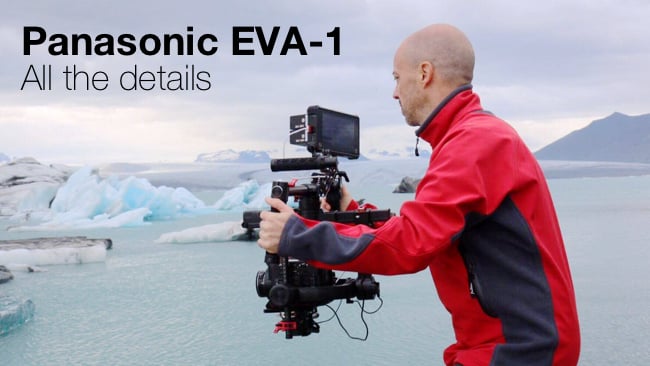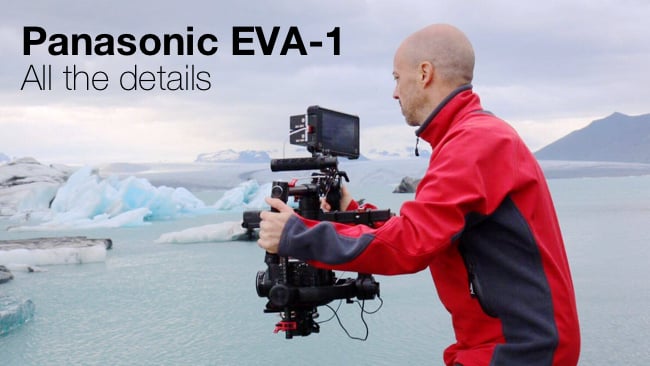
 Panasonic EVA-1 in Iceland
Panasonic EVA-1 in Iceland
Panasonic's smallest Varicam, the EVA1, has been a tantalising prospect since it was announced in June. Now we have the details, it just keeps getting better.
Panasonic’s new 5.7K mid range camera was revealed to the world at Cinegear in Hollywood just a few months ago.
When we saw it, on a picnic table in the sunshine, it looked like the real deal, and it wasn’t at all obvious that this was a pre-production model mostly made out of wood.
Obviously this isn’t the most substance for a working cinema camera and so it won’t be a surprise that when the camera ships it will be made of a more conventional material.
At that time, we were short on specifics. Now we have them.
Here, briefly, are the headlines.
Price
We have it in Euros, which these days are equivalent to around US$1.18. The price for the body alone will be €7,290. Considering the camera’s capabilities, we would say that at the very least that’s competitive.
Sensor
The exact pixel size of the sensor will be 5720 x 3016. That gives a total pixel count of 17.25 million. Significantly, that’s around twice the 8.8 million needed for 4K DCI.
Internally, the highest recordable resolution is 4K DCI, but all output resolutions - 4K DCI, 4K UHD, 2K, 1080p and 720p will be downsampled from the full pixel array.
Panasonic says “the increased colour information results in a finer, more accurate finished image”.
Dual native ISO
The EVA1 inherits this capability from the bigger, more expensive Varicams. And it’s a game-changer. It is exactly as claimed: two completely different native ISOs, one at 800 and one at 2,500. The other Varicams achieve a higher iso of 5000, but don’t think that 2,500 will be significantly less useful because it won’t be.
The prospect of virtually noise-free shooting at ISO 2,500 will be extremely tempting and will radically change the basic needs around lighting on set and the ability to shoot outdoors in low light conditions.
Panasonic explains: "The camera can switch from a standard sensitivity to a high sensitivity with almost no increase in noise or other artefacts”.
Dynamic range
This is now stated as 14 stops: ideal for HDR acquisition. In order to deliver this dynamic range the EVA1 has full V-Log/V-Gamut, and will deliver a full BT.2020 colour space.
Lenses, ND and stabilisation
The lens mount is native EF. This will allow users to choose form a very wide range of cinema-style and still lenses. In body Electronic Image Stabilisation will help with handheld shots and we wonder if it makes use of the high pixel count from the sensor.
There’s an integrated ND filter system with 2, 6 and 6 stops of range. It’s also possible to move the IR filter out of the optical path - which opens up some interesting possibilities for surreal IR type images.
The ND filter and the IR filter are operated electronically and can be remote controlled from smartphones and tablets via an EVA1 remote app.
Recording media
Recording is to low-cost SD cards. There are two slots and it’s possible to record to both simultaneously or sequentially for continuous recording.
Compression and codecs
The headline feature with the EVA1 is 10 bit recording in 4:2:2 - up to and including 4K DCI. A future update will enable i-Frame only (intra frame) compression. Initial bitrates range from 8Mbit/s to 150 Mbit/s. Future firmware will increase this to 400 Bit/s. There is no indication that raw recording will be anything other than via an external recorder. Codecs are AVCHD for 720p and 1080p, and .mov for 1080p and above. Note that SDXC cards are needed for .mov recording.
High speed recording
For high-speed capture, the EVA1 will have up to 59.94fps/50fps for 4K/UHD, up to 120fps/100fps for 2K/Full HD, or 240fps/200fps (cropped area).
Finally
This is exciting news about a really important camera. Of course the proof is in the pictures and we don’t have those yet but we will have a camera as soon as it is physically possible.
There is a tangible sense of new ground being broken with the EVA1. Panasonic is in a good place now with its 4K camera range. And customers are in a good place too. It really makes you wonder what could possibly come next.
3RD AUGUST 2017Panasonic Announces Pricing, additional Technical Specs For AU-EVA1 Compact Cinema Camera
Panasonic today disclosed additional information, including pricing and specification data, about the upcoming AU-EVA1 5.7K handheld cinema camera. Previewed this spring at Cine Gear Expo, the EVA1 will ship this autumn with a suggested list price of €7,290.
Technical specifications now include a pixel count of 5720 H x 3016 V (17.25 million), confirmed dual native ISO ratings of 800 and 2,500, and 14-stops of dynamic range.
“The EVA1’s 5.7K Super-35 sensor has almost twice as many photosites as 4K,” noted Luc Bara, Technical Product Manager for Panasonic. “That means the 4K videos recorded in the camera will be crystal clear with rich colour information.
The EVA1 also inherits the unique dual native ISO sensor technology from our cinema VariCam line, allowing it to shoot in bright sunlight or night exteriors without compromising the image quality. And the 14 stops of dynamic range capture a huge scope of exposure detail.”
The newly-designed EVA1 sensor is Super-35 sized (24.60mm x 12.97mm) with 5.7K resolution. With an active resolution of 5720 x 3016, the EVA1 delivers more than 17.25 million photosites, nearly double the 8.8 million for 4K DCI (4096 x 2160). By starting at a higher native resolution, the 5.7K sensor yields a higher resolving image when down-sampled to 4K, UHD, 2K, or even 720p. Additionally, the increased colour information results in a finer, more accurate finished image.
A key feature of the VariCam cameras, dual native ISO utilises a process that allows the sensor to be read in a fundamentally different way, extracting more information without degrading the image. This results in a camera that can switch from a standard sensitivity to a high sensitivity with almost no increase in noise or other artefacts. Dual native ISO has allowed cinematographers a greater variety of artistic choices as well as the ability to use less light on set, saving time and money. The EVA1’s dual native ISOs are 800 and 2,500, which will allow cinematographers to shoot in almost any lighting environment.
The EVA1 delivers 14-stops of dynamic range, enabling fine gradation in exposure from bright to dark. The ability to capture accurate colours and rich skin tones is a must for any filmmaker. The EVA1 features full V-Log/V-Gamut capture to best utilise high dynamic range and broad colours. V- Log has log curve characteristics that is HDR ready and V-Gamut delivers a colour space that will cover BT.2020.
Weighing only 1.2Kg (body-only) with a compact form factor (17cm H x 13.5cm W x 13.3cm D) and a removable handgrip, the EVA1 can be used for efficient handheld shooting applications. Because of its compact form factor, it can also be mounted on a drone, gimbal rig or jib arm for complex yet smooth camera moves. There will also be numerous mounting points and Panasonic is currently working with top accessory makers to allow further customisation with the EVA1.
The included adjustable handgrip offers several controls, including Menu, REC start/stop, Iris and Two User Buttons. The EVA1’s LCD screen is a 3.5” touch panel for menu selections, expand (image zoom) positioning and playback controls. The LCD has an adjustable backlight control, including a Power LCD mode for bright viewing conditions.
For lensing, the camera utilises a native EF-mount, giving shooters access to the broad EF lens ecosystem, including dozens of cinema style prime and zoom lenses from numerous manufacturers. Electronic Image Stabilisation (EIS) within the camera will counterbalance camera shake and blurring, enabling smooth movement for handheld shooting. There will also be full Iris Control, One- Push Auto Focus, and Lens Data.
Behind the lens mount, an integrated ND filter wheel in 2, 4, and 6 stops allows for precise exposure control. The EVA1 also allows the IR Cut to be swung out of the path to the sensor at the push of a button. Unique photographic effects and night vision imagery are possible with this control over infrared.
The ND filter and IR Cut filter operate electronically, allowing wireless remote control from smartphones and tablets. EVA1 will have a remote control app for a tablet (iOS, Android) that enables users to control an EVA1 when the camera is on a camera crane, or remote location.
Ideal for indie filmmakers, the EVA1 records to readily-available, lower-cost SD cards. With two SD card slots, you can capture footage either with simul rec (simultaneous dual record) or relay record (continuous record).
There’s also one shot record, which enables single frame video for stop motion capture.
The camera can record in several formats and compression rates, and offers up to 10-bit 4:2:2 even in 4K. For in camera recording, you can capture in 4K (4096 x 2160), UHD (3840 x 2160), 2K (2048 x 1080), Full HD (1920 x 1080), and HD (1280 x 720). In a future firmware upgrade, EVA1 will offer ALL Intra compression for in camera recording and 5.7K RAW output to third party recorders.
For high-speed capture, the EVA1 offers up to 59.94fps/50fps for 4K/UHD, up to 120fps/100fps for 2K/Full HD, or 240fps/200fps (cropped area).On first release, available bit rates will range from as low as 8Mbps up to 150Mbps, depending on frame rate, resolution, and codec. In a future firmware update, 400Mbps recording will be added.
As a professional video production tool, EVA1 contains several professional imaging tools, including peaking, expand (Image Zoom), waveform, zebras, and spotmeter (Y-Get). EVA1 also utilises focus squares, an array of green squares that grow in size when their local area appears to be sharp, to enable shooters to achieve critical focus.
EVA1 offers dual balanced XLR audio inputs with Dolby AudioTM encoding. The HDMI and SDI video outputs are both 4K-capable and each can be adjusted separately, allowing HD to be fed to a viewfinder or other third party monitor while 4K is sent to an outboard recorder or monitor. The camera is also equipped with standard TimeCode functionality.
For more information about the AU-EVA1, visit http://business.panasonic.co.uk/professional- camera/camcorders/AU-EVA1-cinema-compact-camera<ENDS>
Tags: Production


Comments